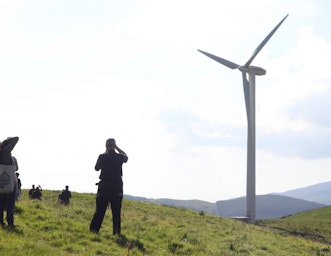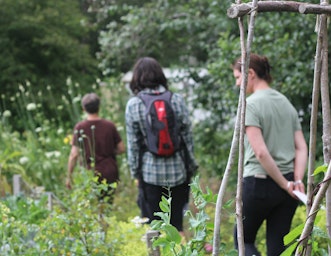
Next in our series looking at themes and topics explored by students on CAT Masters degrees, Alan Owen introduces community solar, which we teach to students on a number of our postgraduate courses, including our Sustainability in Energy Provision and Demand Management MSc.
We often associate community energy projects with microhydro schemes or wind turbines, with share offers and investment opportunities for local people. However, at an even more local level, and particularly in towns and cities, we can work on a street-by-street basis to implement community solar schemes that can bring significant environmental and cost benefits.
As well as teaching CAT Graduate School students about this topic, we also provide training to community groups to help people implement renewable energy schemes of their own.

Why is the topic important?
Avoiding catastrophic climate breakdown demands we move away from fossil fuels and towards more sustainable means of energy production. This means both significantly powering down energy demand, through improvements in energy efficiency, changes to transport and transforming industry, and powering up supplies of renewable energy.
By now, we’re all familiar with the environmental and cost-saving benefits of solar photovoltaic (PV) panels. These benefits can be further amplified if people work together to install PV panels across an entire street or housing estate. Whole neighbourhoods can be turned into power stations, supplying renewable electricity all year round.
This community approach allows for a more efficient use of energy, budget and resources than installing panels individually.
- The energy-returned-on-energy invested (EROEI) can be much better for a project covering 20 homes than for 20 individual installations. Factors in this include reduction in resource demand (particularly conflict materials), transport of materials and installers to the site (one trip vs 20 trips) and better use of available space.
- It makes community PV better value for money than a system installed on a single home, because buying the equipment in bulk brings the price down, and installing a larger system takes less time than installing multiple small systems.
- The output is more easily used by everyone, so more of the energy generated is available for displacement, i.e. using energy from a community system at the point of generation displaces grid consumption, which means it has the same value per kWh as buying from the grid, whereas selling back to the grid gives only a small fraction of the income.
- It can introduce greater local energy resilience, as a community supply can easily be set up so that it can connect to and disconnect from the grid as needed.
- Because community PV is more cost effective, supporting street-by-street or whole neighbourhood installations is also potentially a more effective use of government grant funding than providing subsidies or grants for individual households to install PV.
There are also the wider benefits of people getting to know their neighbours better and working together as a community. Solar projects can be a great way to kick-start other community action or build on existing schemes.
What are the main aspects to consider?
First, we teach that reducing energy demand is a crucial step. We explore types of home insulation and ways of reducing energy demand through behaviour change as well as technology use.
Next, we think about the different space available in a neighbourhood. Generally, people’s first thought is to install PV on roofs, but cleaning and maintenance is easier with ground-mounted systems, so suitable areas of land should also be considered.
Wherever PV panels are sited, general rules apply – for example, they need to be south facing and not shaded by trees or buildings to ensure maximum power generation. Students look at these rules in detail.
Finally, we discuss the option for neighbourhood groups to work together to buy shares in a company or community group that is installing renewable energy systems elsewhere – the impact may not feel as direct, but it may be a more efficient use of resources, particularly if their own site isn’t well suited to PV.
What are the teaching methods?
Students learn about community solar through a range of teaching methods:
- Data calculations using Excel spreadsheets and a bit of maths.
- Looking at how PV works, using physics.
- Practical sessions calculating maximum power points, horizon mapping and sun path diagrams to work out what electricity you might expect to generate from PV panels on a particular site.
- Looking at how to create consumption profiles for households – what devices people use, when, how often, and what their power rating is.
- Calculating energy-return-on-energyinvested, looking at the energy it takes to make and install the PV panels vs the expected energy outputs.
- Life cycle analyses, exploring the environmental and human impacts from producing PV panels to end-of-life disposal.
- Using the PV panels on the CAT site to learn how to test output and compare different systems.
External guest lecturers – for example, Nikki Pillinger, ‘The Grid Queen’, a senior engineer who works with big solar installations – add a unique perspective.
But it’s not all about the technical details – we get students thinking about the bigger picture too, looking at how technologies will impact what we do in the future, the benefits and challenges for future societies in terms of resource use, waste disposal, and energy justice. Students consider the future they want to see and the potential impacts of the choices we make today.
How do students use this learning?
Students from a wide range of backgrounds come to study our courses – many of whom are looking to change careers to work in an area they really care about and that will allow them to make a positive impact in the world.
Many CAT graduates have gone on to work in community energy schemes or with local authorities across the UK.
We also have graduates working to advance renewable energy in other countries around the world. For example, a graduate who used to work in the medical industry and had no engineering background is now working in energy management in South East Asia.
Study with us
Find out more about CAT Masters degrees, join an on-site or virtual open day, and explore what funding might be available to you – visit our Graduate School web pages or contact Alis at study@cat.org.uk or on +44 (0)1654 705953.
Alan also teaches our ‘Renewable Energy for Households’ series of one-day courses, covering everything from heat pumps to solar. Find out more on our short courses pages.
About the author
Alan is a Senior Lecturer in CAT’s Sustainability in Energy Provision and Demand Management MSc, and teaches renewable energy systems on a number of our other Masters degrees and short courses. He is a Chartered Energy Engineer, with 30 years’ experience in renewable energy and has taught at a number of universities, including Heriot Watt and Robert Gordon.
- Graduate School
- Energy
- News Feed
Related Topics
Related Pages
Related events


The Science of Sustainable Food Production (Sold out)
30th June 2025
Virtual Open Day: MArch Sustainable Architecture Part 2
7th July 2025
Regenerative Futures – Architecture Summer School
14th July 2025GRADUATE SCHOOL OF THE ENVIRONMENT
ACT NOW FOR A SUSTAINABLE FUTURE
Learn more about our exciting postgraduate courses and sign up for our emails to stay up-to-date on all the latest.
